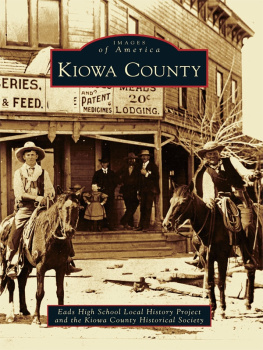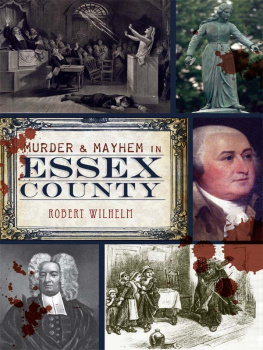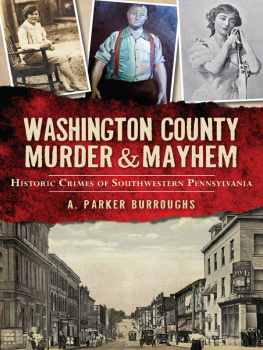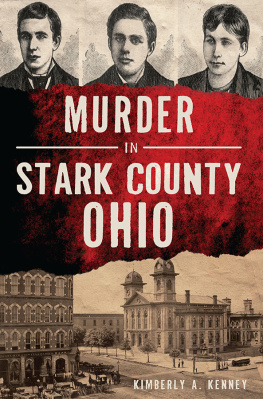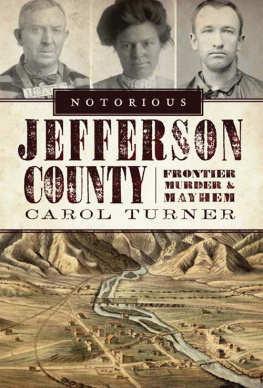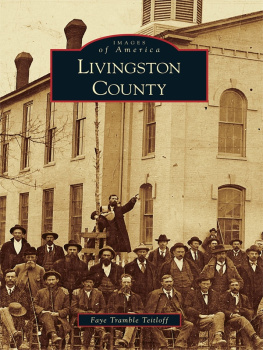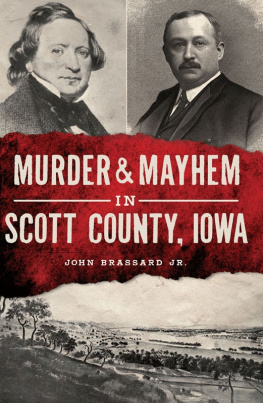
Published by The History Press
Charleston, SC 29403
www.historypress.net
Copyright 2010 by Joseph David Cress
All rights reserved
All images courtesy of the Cumberland County Historical Society unless otherwise noted.
First published 2010
e-book edition 2011
ISBN 978.1.61423.251.3
Cress, Joseph David.
Murder & mayhem in Cumberland County / Joseph David Cress.
p. cm.
Includes bibliographical references.
print edition ISBN 978-1-59629-884-2
1. Murder--Pennsylvania--Cumberland County--History--Case studies. 2. Violent crimes--Pennsylvania--Cumberland County--History--Case studies. I. Title. II. Title: Murder and mayhem in Cumberland County.
HV6533.P4C74 2010
364.15230974843--dc22
2010024022
Notice: The information in this book is true and complete to the best of our knowledge. It is offered without guarantee on the part of the author or The History Press. The author and The History Press disclaim all liability in connection with the use of this book.
All rights reserved. No part of this book may be reproduced or transmitted in any form whatsoever without prior written permission from the publisher except in the case of brief quotations embodied in critical articles and reviews.
CONTENTS
ACKNOWLEDGEMENTS
First of all, I want to thank my wife, Stacey, along with our friends and family who continue to support me as I take my writing in a new and exciting direction. Your love has made it possible for me to fulfill a dream. I also dedicate this book to the memory of two souls who had a profound impact on my life.
My mother, Christina, encouraged me from an early age to pursue writing as both a passion and career. From her, I learned how to take a stand, question authority, dare to be different and persevere.
A dear friend, Bob Missimer, had the storytelling giftthe power to move you with just the sound of his voice. His was a creative soul taken from us too soon. From Bob, I learned to be confident and unafraid of what others may think of me. I learned that life is too short to sit and wonder how to make your dreams come true.
I also want to thank the dedicated and professional staff at the Cumberland County Historical Society (CCHS). They helped me immensely in the research that went into this project. Special thanks go out to the crew in the photo archives, who worked under a tight deadline to deliver the images found in this book.
My gratitude also goes out to the leadership team at the Sentinel newspaper and to the editorial staff at The History Press for all the opportunities you have given me over the years.
INTRODUCTION
Every community, large and small, has its share of black marks mixed in with a colorful past. These shady spots of tragedy and outrage, treachery and madness, have their own dark allure that can light our path to a greater understanding of the human condition.
Cumberland County in Pennsylvania is no different. Darkness always lingers beneath layers of civility, and when it shows itself, we are left both shocked and morbidly curious. We may not like what we see, but when we think about how fragile life is, some good may come out of this quiet reflectionsomething of the light may shine through for us.
When I set out on this path in October 2009, I wanted this book to be a mixture of murder and mayhem both high-profile and virtually unknown. I thought if I could lace my poison pen with such a wide variety of cases, I could draw the attention of readers new to local history and county historians in search of fresh insight. For this, my second book, I purchased some scary soundtracks in eager anticipation of spending hours in a dimly lit corner of my attic office enjoying the craft of writing. After weeks spent in research, the first chapter was written on Halloween. I thought, how appropriate.
You hold in your hands the product of six months of research and writing. There are twenty sections arranged chronologically under six thematic parts. Within these pages are the confessions of the condemned, the musings of poets, eyewitness testimony and media reports spanning more than 225 years of Cumberland County history, from the Pontiac War to the Camp Hill Prison Riots.

The American Volunteer newspaper was printed out of this office on South Bedford Street in Carlisle circa 1880s. The site is now occupied by the First Lutheran Church.
Brace yourself going forward. This is not for the meek or fainthearted. You will stare into the eyes of a murderer who changed courthouse security. You will see the faces of three sisters killed out of mercy and torment. You will read the words of a crazed alcoholic who thought that his wife could assist in his suicideafter she was dead. And you will meet two young sweethearts forever united in death by a single fatal bullet.
It has often been said that journalism is history in its first draft. After almost twenty years of being a reporter, I feel my age and wonder what history I have chronicled for future generations to draw from. Much of what follows is based on firsthand accounts by fellow journalists, many of whom had their names lost to history before bylines were a common newsroom practice.
This book is for them to show the public that there is value in newspapers even as the industry struggles to stay relevant and competitive in a noisy world crowded with demands for our attention. The hard work and dedication of these journalists made this history of murder and mayhem possible. It is my hope that you, the reader, will come to honor them and to learn from them as much as I have.
PART I
BLOOD FOR BLOOD
Terrorism is not a modern invention, nor is the blood feud. Cumberland County in the 1760s stretched beyond Pittsburgh and occupied much of southwestern Pennsylvania. The modern towns of Carlisle and Shippensburg were outposts on the edge of civilization and a sparsely populated wilderness. As settlers moved west, they encroached on native territory, setting the stage for mayhem and atrocities committed on both sides. The ferocity of the terror raids would cast the Indian as a brute deserving of conquest, while equally violent men among the colonists would escape justice. In between, women and children paid the price.
T HE G REATEST M ELANCHOLY : T HE P ONTIAC W AR
Terror stalked the hills and valleys beyond Carlisle. Months had passed since the Indian tribes unleashed the Conspiracy of Pontiac on unsuspecting settlers of what was then a vast Cumberland County. The attacks sprang out of lingering rage brought on by broken promises made by the British empire. Before it was over, the Pontiac War would leave behind a landscape virtually empty of colonists but full of death and devastation. The county seat of Carlisle had become an emergency refugee center.
Soon after his arrival in town, Reverend William Thomson wrote a letter dated July 18, 1763, to the Society for the Propagation of the Gospel. In it he described the desperate suffering of the people, along with his own frustration over not being able to safely work his circuit of churches. What made conditions even more deplorable was the stark reality of having no relief in sight from the ravages of what he called the Heathen:


